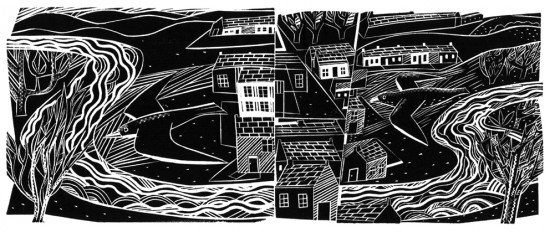 illustration by Jonathan Gibbs
illustration by Jonathan Gibbs
By Neil Sentance.
1955: River Cycling and other ‘Stunts’
After the war all the riverside houses had long gardens and people tended vegetable plots that reached to the banks. When they needed water they would use a stirrup pump with a long hose pipe and draw from the river into the gardens. No doubt this contributed to the low midsummer water levels, down to 12’’ or less. Willows drooped low over the surface like shawled old ladies, their slender tendrils hiding warring coots, and breaking the waterline and generating micro-eddies. For the local kids this was their playground and they would do all sorts of ‘stunts’. Stan Hood, one of the older lads, was the leader, running wild as his dad worked away as a cooper in Burton on Trent. Carrying youngsters across the river on big stepping stones lumped from the quarry up the road, he sometimes jumped in, drenching them both. He was like the mythical scorpion that stings the frog carrying it across the stream – it was in his nature. He’d throw magnesium flares at the other kids’ feet, just to ‘upskittle’ them, and instituted the pinching candle rite for membership of his mob. In the winters, his gang roller-skated in the snow, up the wide paths of Somerby Hill, ringing doorbells and hightailing away. Householders were ready for it – to escape the kids had to climb the five-bar gates of Swallows Mill, still on skates. Stan wore a faded pin-stripe suit, but his acolytes would never let him hear them saying he had had to stay up all night to paint on the lines. He was ‘soft as grease’, Dad said.
Dad, forever whittling and working wood, once spent weeks making a yacht, honed on a spokeshave, then launched with fanfare from an embayed island in the stream, but the string broke on the maiden voyage and it drifted downstream and out of reach. Another time he rigged ex-ministry telephones from one side of the river to the other, ringing Fabian of the Yard, Whitehall 1212. Maybe that was the same day that Alan Briggs’s sister put her head through the iron railings of the bridge and got it stuck. Her dad had to come and get her out with a crowbar – the railings remained there, deformed, for years until eventually a lorry lost control coming down the hill, hit the bridge and sent the whole lot plummeting into the river.
Dad and his mates would live the summer on bikes, riding through the low turbid water and under the river bridge towards the mill, deaf to the angry shouts of older lads fishing with split-cane rods for trout. And then up the bank and off into the country, back to the river’s younger self, to the dens of Robbers Rocks and past the vast cetacean jawbone placed on the roadside that gave its name to Whalebone Lane, and beyond, along the High Dyke to Woodnook, freedom transmitted with every derailleur gearshift.
Other times they would follow the spring line up Halls Hill, windy heights above the town where Dad as a young lad had put stones in his pockets, thinking he’d be blown into Leicestershire. They’d go up ‘Monkey Millward’s Lane’ – old Millward had once brought some monkeys back from a trip abroad and kept them in heated outbuildings on the farm until in a power cut one cold winter night they all froze to death. One summer Dad found an old motorbike in Millward’s field and managed to get it going, larruped in engine oil, he said. The old man took the front wheel off in an attempt to forestall these high-jinks but Dad merely replaced it with a wheelbarrow wheel and raced over the rutted tracks and through swards of rough meadow-grass and cornflowers, round the stands of pollarded oaks, until the petrol ran out or the dusk descended with the swallows dipping round the beanpoles.
Click here to read previous Scenes from the Waterside
The author and the editors would like to thank Simon Lewin at St Judes gallery for his help in finding the correct artist to illustrate this column. Thank you Simon and thank you Jonathan for your fine work.